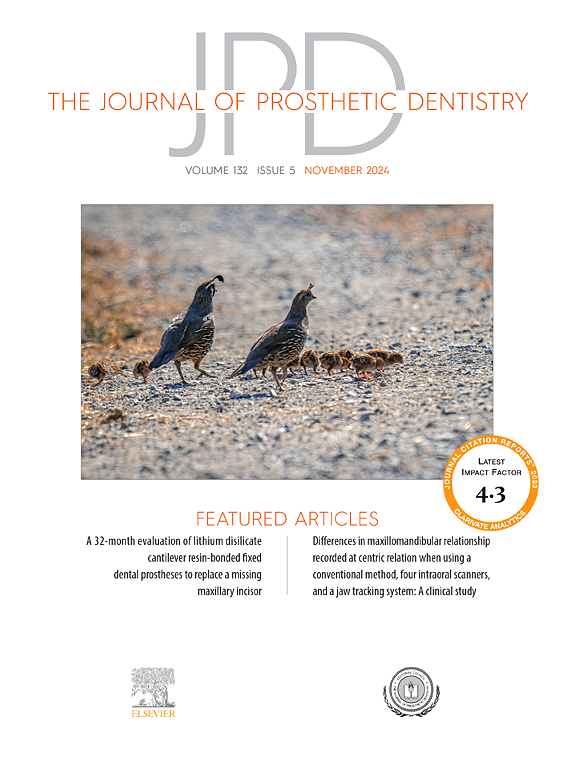Image-guided photogrammetry accuracy: In vitro evaluation of an implant-supported complete arch digital scanning technology
IF 4.8
2区 医学
Q1 DENTISTRY, ORAL SURGERY & MEDICINE
引用次数: 0
Abstract
Statement of problem
Complete arch digital scanning with intraoral scanners (IOSs) for implant-supported fixed dental prostheses (FDPs) is controversial with current technologies, and accuracy and consistency are insufficient. Stereophotogrammetry (SPG) may capture precise implant coordinates but unrelated to the patient anatomy. Conclusive data comparing IOS versus SPG are lacking.
Purpose
The purpose of this in vitro study was to investigate a novel image-guided photogrammetry (IGP) navigation technology for complete arch digital scanning with an artificial intelligence (AI) driven workflow to superimpose implant coordinates on preoperative patient data sets.
Material and methods
After ethical approval had been received for the use of human-derived data, complete arch casts of actual patients with 4 and 6 implants were selected from an archive. Digital scans were made with IGP and a coordinate measuring machine (CMM) to generate standard tessellation language (STL) test and reference files for each cast, which were then superimposed with a best-fit algorithm. For each implant position, linear along x- (longitudinal), y- (lateral), and z- (vertical) axes (ΔX, ΔY, ΔZ) and angular (ΔANGLE) deviations were calculated. Three-dimensional (3D) deviation (ΔEUC) was measured as the Euclidean distance. Sample size was calculated assuming ΔEUC as the primary endpoint, significance level of.05, n=84 to ensure a minimum expected difference of 120 µm (standard deviation 150 µm), and test power of.95. A univariate descriptive analysis of study variables was performed and stratified by implant number (4 versus 6). An independent samples t test was used to assess whether ΔEUC and ΔANGLE differed significantly based on implant number (4 versus 6) and position on the arch (anterior versus posterior for 4-implant casts) and anterior, intermediate, and posterior for 6-implant casts) (α=.05).
Results
A total of 26 complete arch casts, mandibular (n=16) and maxillary (n=10) with 4 (n=15) or 6 (n=11) implants, were investigated. A total of 126 implant positions were captured with IGP technology and compared with respective references (n=26 test, n=26 reference files). Mean deviations, standard deviation, range, and 75 percentiles were calculated for ΔX (−0.05 ±29.95; −75.17 - 68.00; 22,00 µm), ΔY (0.01 ±31.65; −68.0 - 93.93; 19,18 µm), ΔZ (−0.02 ±12.95; −39.0 - 43.5; 6,76 µm), ΔEUC (43.02 ±26.24; 3.41 - 190.23; 58,21 µm), and ΔANGLE (0.43 ±0.22; 0.03 - 0.86; 0,61 degrees). Lower deviations were found in 4-implant casts ΔEUC (P=.017), ΔANGLE (P=.003). Implant position did not affect accuracy, with the exception of ΔANGLE on 6-implant casts, and anteriors performed worse than posteriors and intermediate implants (P=.009).
Conclusions
Image-guided photogrammetry was feasible for implant-supported complete arch digital scanning with linear and 3D deviations lower than those of conventional SPG. Linear deviations were close to 0 µm and angular deviations about 0.4 degrees, with the 4-implant casts being more accurate. Implant position did not affect accuracy with the exception of anterior implants that showed higher angular deviations in the 6-implant casts. Even though actual patient casts were investigated, allowing the IGP outcomes to be generalized with caution, trials are needed to validate its clinical performance.
图像引导摄影测量精度:一种种植体支持的全弓数字扫描技术的体外评估。
问题陈述:使用口腔内扫描仪(ios)对种植支撑固定义齿(fdp)进行全弓数字扫描与当前技术存在争议,准确性和一致性不足。立体摄影测量(SPG)可以捕捉到精确的植入物坐标,但与患者的解剖结构无关。比较IOS和SPG的结论性数据是缺乏的。目的:本体外研究的目的是研究一种新的图像引导摄影测量(IGP)导航技术,用于全弓数字扫描,该技术采用人工智能(AI)驱动的工作流程,将植入物坐标叠加到术前患者数据集上。材料和方法:在获得使用人源性数据的伦理批准后,从档案中选择实际患者的完整弓型,植入4个和6个植入物。使用IGP和坐标测量机(CMM)进行数字扫描,为每个铸型生成标准镶嵌语言(STL)测试和参考文件,然后将其与最佳拟合算法叠加。对于每个种植体位置,计算沿x轴(纵轴)、y轴(横轴)和z轴(纵轴)(ΔX, ΔY, ΔZ)和角(ΔANGLE)的线性偏差。三维(3D)偏差(ΔEUC)测量为欧几里得距离。样本量计算以ΔEUC为主要终点,显著性水平为。05, n=84,以确保最小期望差为120µm(标准差为150µm),测试功率为。95。对研究变量进行单变量描述性分析,并按植入物数量(4对6)分层。采用独立样本t检验来评估ΔEUC和ΔANGLE在种植体数量(4个vs 6个)和在弓上的位置(4个种植体的前位vs后位)以及6个种植体的前位、中间位和后位)上是否有显著差异(α= 0.05)。结果:共26个完整弓型,下颌骨(n=16)和上颌(n=10),种植体4 (n=15)或6 (n=11)。IGP技术共捕获126个种植体位置,并与各自的参考文献(n=26个试验,n=26个参考文件)进行比较。计算ΔX的平均偏差、标准差、极差和75百分位数(-0.05±29.95;-75.17 - 68.00;22 000µm), ΔY(0.01±31.65;-68.0 - 93.93;19.18µm), ΔZ(-0.02±12.95;-39.0 - 43.5;6,76µm), ΔEUC(43.02±26.24;3.41 - 190.23;58,21µm), ΔANGLE(0.43±0.22;0.03 - 0.86;0, 61度)。4种植体铸型的偏差较低ΔEUC (P= 0.017), ΔANGLE (P= 0.003)。种植体位置不影响准确性,除了在6种植体铸型中ΔANGLE,前种植体比后种植体和中间种植体表现差(P= 0.009)。结论:图像引导摄影测量在种植体支撑的全弓数字扫描中是可行的,其线性和三维偏差均低于传统SPG。线性偏差接近0µm,角偏差约0.4°,4种植体铸造精度更高。除了前路种植体在6种植体铸型中显示较高的角度偏差外,种植体位置不影响准确性。尽管对实际的患者铸型进行了调查,使IGP的结果可以谨慎地普遍化,但仍需要试验来验证其临床表现。
本文章由计算机程序翻译,如有差异,请以英文原文为准。
求助全文
约1分钟内获得全文
求助全文
来源期刊

Journal of Prosthetic Dentistry
医学-牙科与口腔外科
CiteScore
7.00
自引率
13.00%
发文量
599
审稿时长
69 days
期刊介绍:
The Journal of Prosthetic Dentistry is the leading professional journal devoted exclusively to prosthetic and restorative dentistry. The Journal is the official publication for 24 leading U.S. international prosthodontic organizations. The monthly publication features timely, original peer-reviewed articles on the newest techniques, dental materials, and research findings. The Journal serves prosthodontists and dentists in advanced practice, and features color photos that illustrate many step-by-step procedures. The Journal of Prosthetic Dentistry is included in Index Medicus and CINAHL.
 求助内容:
求助内容: 应助结果提醒方式:
应助结果提醒方式:


